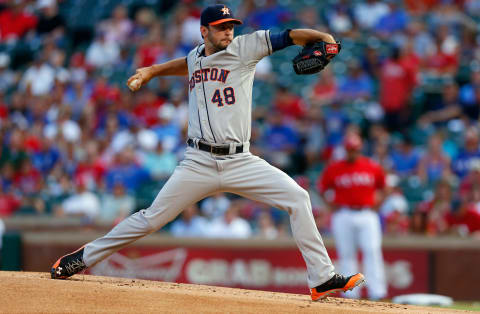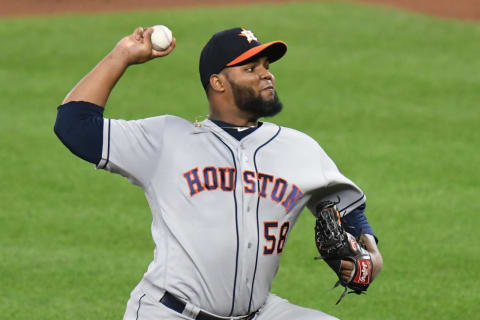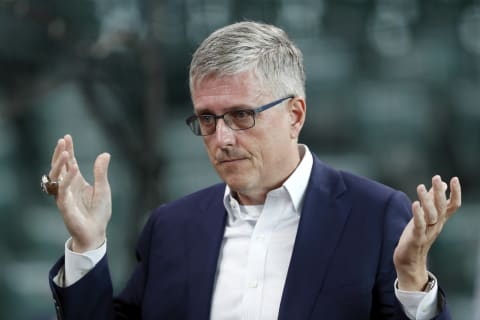Astros: Reviewing the Jarred Cosart for Jake Marisnick trade

We look back at the 2014 trade in which the Houston Astros sent Jarred Cosart to the Marlins for Jake Marisnick.
There have been some head scratching trades made by the Houston Astros over the years. This one doesn’t necessarily fall into that category, but it was certainly a surprise when it went down. The rebuilding franchise traded away a young pitcher in Jarred Cosart for a package that included future fan favorite Jake Marisnick.
The trade took place at the July 31 deadline in 2014, when the Astros weren’t quite ready to contend (but were closer than many thought). But they traded Cosart along with utilityman Kike Hernandez and minor league outfielder Austin Wates to the Marlins in exchange for Marisnick, third baseman Colin Moran, pitcher Francis Martes and a 2015 competitive balance round A draft pick.
There were plenty of names exchanged in this trade, and several of them have since been traded again. It’s interesting how one trade can lead to another, and this one has numerous branches coming off of it. This also makes it a little more difficult to grade the trade in hindsight, but we’ll take our best shot at it.
We’ll look at what value the players actually gave their new organizations while they were there, and what sort of value the since-traded players brought back. There’s plenty to unpack here, so let’s get to it.

What the Astros Gave Up
Let’s start with Cosart, who was the apparent centerpiece of this deal at the time. He was a 38th-round draft pick by the Phillies in 2008 and came to Houston in the Hunter Pence trade in 2011. He burst onto the scene as a 23-year-old in 2013 by pitching to a 1.95 ERA in 10 starts, though his peripherals were not good. He walked more batters than he struck out, and FIP had him pegged at a much higher 4.35.
In 2014 prior to the trade, he was 9-7 with a 4.41 ERA in 20 starts for the Astros. After the trade, he went 4-4 with a 2.39 ERA in 10 starts for the fish. He made only 13 starts and one relief appearance in 2015, going 2-5 with a 4.52 ERA. He pitched to a 5.95 ERA in four starts in 2016 before being traded to the Padres in a seven-player deal. We’ll go into detail on that trade later, but for now let’s just say the Marlins didn’t make out all that well.
Cosart put up a 5.58 ERA in parts of two seasons with the Padres and hasn’t pitched in the majors since. He provided a total 1.8 WAR for the Marlins, mostly thanks to his strong 10-start run in 2014. This came after he’d put up 2.9 WAR in parts of two seasons in Houston.
Hernandez made his major league debut with the Astros in 2014, hitting .284/.348/.420 in 24 games. He hit only .175 in 18 games for the Marlins after the trade and was traded that offseason to the Dodgers in a deal that sent Dee Gordon to Miami. The Dodgers also got catcher Austin Barnes, reliever Chris Hatcher and starting pitcher Andrew Heaney, the latter of whom was immediately flipped to the Angels. The Marlins also got pitcher Dan Haren and infielder Miguel Rojas.
Hernandez quickly became a valuable utility player for the Dodgers, hitting .307 in 2015 and popping 21 homers in 2018. He’s played all the infield and outfield positions and has been worth 6.0 WAR for the Dodgers. In his brief stint with the Marlins, he was worth 0.2 WAR.
Wates was a former third-round draft pick who never reached the major leagues. He last played in the minors in 2015, so he ended up providing no value to the Marlins.

What the Astros Got
The most familiar name to fans is Marisnick, whose Houston tenure just ended with his trade to the Mets this past offseason. He’d appeared in a total of 54 games with the Marlins between 2013 and 2014, hitting .178 and compiling exactly zero WAR.
Marisnick gave the Astros an even 10 WAR in six seasons, serving as a defensively gifted fourth outfielder and occasional pinch runner with a little pop in his bat. His best year by WAR standards was 2015 when he hit .236 but stole 24 bases. His best offensive season was 2017 when he hit 16 homers in 106 games. It’ll be some time before we can fully evaluate the trade sending him to the Mets in exchange for minor league pitchers Blake Taylor and Kenedy Corona, but Marisnick was the most valuable player to either team in terms of what he did on the field.
Moran was the sixth overall pick in 2013 by the Marlins, and he made brief appearances in the major leagues with the Astros in 2016 and 2017. In total, he played in 16 games, compiled a .653 OPS and was worth -0.2 WAR. He was sent to Pittsburgh in the Gerrit Cole deal prior to the 2018 season.
Since the trade, he’s been worth -0.5 WAR in two seasons for the Pirates while serving as their everyday third baseman. He’s been about league average with the bat, with an OPS+ of 101, but the defensive metrics have not been kind to him. With Alex Bregman already in the fold, Moran was expendable for the Astros.
Martes rose to become one of the Astros’ top prospects before making his big league debut in 2017. He pitched to a 5.80 ERA in four starts and 28 relief appearances that year with high strikeout and walk rates. He has not pitched in the majors since then thanks to Tommy John surgery and two PED suspensions, the latest of which has him out for all of 2020. He was worth -0.9 WAR in his lone major league season.
The Astros also got a draft pick in the competitive balance round A for 2015, which they used on outfielder Daz Cameron, son of former major leaguer Mike Cameron. The younger Cameron was sent to the Tigers in the Justin Verlander trade in 2017, and he’s yet to make the majors. Our postmortem review of that trade leans heavily in favor of the Astros, as Cameron hit just .214 in Triple-A in 2019.

The Final Verdict
The Marlins got a total of 2.0 WAR from Cosart and Hernandez, neither of whom is still with the team. The Astros got a total of 8.9 WAR after accounting for the negative value supplied by Moran and Martes, so in a strict on-the-field comparison, the Astros did better, solely thanks to Marisnick.
Of course there are the additional layers to this in the fact that several of these players were traded again. The Astros were able to flip Moran and Cameron in deals for Cole and Verlander, which helped get them a pair of bona fide aces the past two years. Verlander, in particular, helped the club to a World Series title in 2017. He’s given the club 16.1 WAR in two seasons plus a month of 2017, while Cole provided 12.3 WAR in two seasons.
The Marlins used Hernandez to help them grab Gordon, Haren and Rojas. Gordon won a batting title and gave the team 8.2 WAR in three seasons before being traded to Seattle, Haren gave them 2.0 WAR in a partial season, and Rojas has given them 5.9 WAR in five seasons.
More from Climbing Tal's Hill
- Just how much better is the Houston Astros playoff rotation than the rest?
- Houston Astros: A Lineup Change to Spark Offense
- Astros prospect Hunter Brown throws 6 shutout innings in debut
- Always faithful Astros World Series champion Josh Reddick defends the title
- Michael Conforto declines Astros’ 2-year, $30 million offer
The Marlins got a combined -2.0 WAR from the three players they received from the Padres in exchange for Cosart, Carter Capps, Luis Castillo and Josh Naylor. However, this trade had a wrinkle in that a few days later, Castillo was sent back to the Marlins and Rea was sent back to the Padres after Rea left his lone Miami appearance with an injury.
The Padres got -0.7 WAR combined from Cosart, Capps and Naylor. Castillo was later traded to the Reds and has since blossomed into a promising young pitcher, but neither the Marlins nor the Padres saw that come to fruition. Rea has not pitched in the majors since that 2016 season.
So the Marlins made out fairly well in the Hernandez trade, but not so well in the Cosart deal. In the end, it’s tough to fully grade the subsequent deals given that there are other players involved, but the Astros flipped Moran and Cameron in two great trades, while the Marlins flipped Cosart and Hernandez in one solid deal and one poor deal.
That, combined with the fact that the Astros simply got more WAR on the field from the players involved in this 2014 trade with the Marlins, leaves me to grade the Astros as the winners of this trade. Marisnick was the single biggest reason for that, and the club clearly traded Cosart at the right time. This was an unexpected but shrewd move by former GM Jeff Luhnow, and to a certain extent, it helped set the stage for the team’s success these past three seasons.